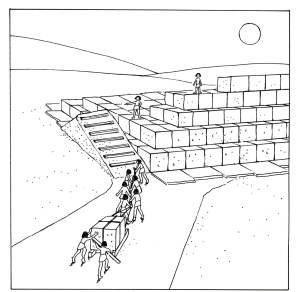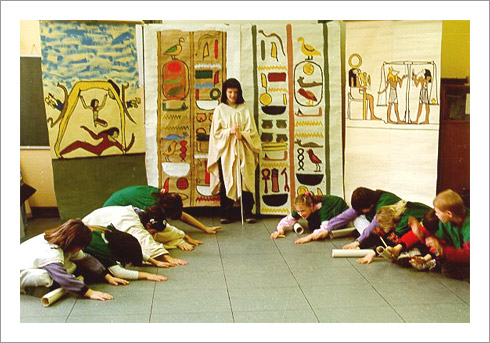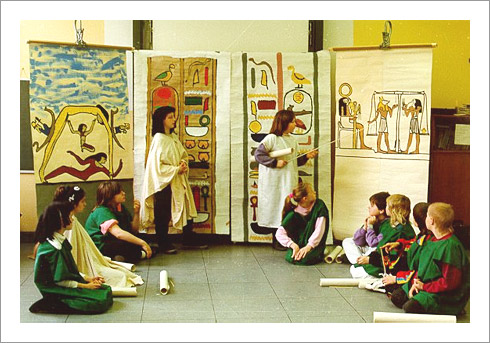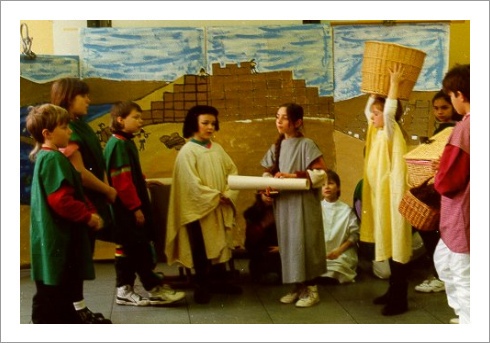|
~ A Pyramid is Built ~ Summary
Excerpts: A Pyramid is Built Prologue
A boy and a girl step in front of the audience. The boy is wearing a long shirt and an old-Egyptian headscarf. The girl is wearing a long white dress (ideally with only one strap) and the old Egyptian female hairstyle. Girl: Dear audience, today in our play we would like to take you into a totally different world as it existed some 5000 years ago. Boy: It is the world of the old Egyptians. And although it may seem strange to us today it still has many things in common with our present world. Many fundamental ideas originate from then. Ideas, that until the present day are very important for all of us. Girl: The old Egyptians used to live in the valley of the river Nile – just like today‘s Egyptians do. Because no one can live outside the Nile-valley as there is nothing but dry, hot desert. Boy: Only in the Nile-valley there is water. Once a year the Nile even overflows its banks and floods a large part of the valley. The flooding lasts for three months. Girl: The floods are very beneficial for the people who live there. The land is watered and well fertilised with the mud that the Nile deposits on the fields. Without the floods very little would grow in the valley of the Nile. Boy: The old Egyptians were obviously very clever people as they had found out what to do in order to be able to live a comfortable life in such an environment. Girl: Dear audience, please follow us now into the world of pyramids, pharaohs and mummies. End of Prologue
.... Scene 3 On the Pyramid-building site The central and left stage sets show important parts of the pyramid-building site. On the center part on the right one can see the pyramid, which is only partially completed. It is not yet covered and therefore still step-shaped. An uneven ramp leads from the left to the upper platform of the pyramid.. On the pyramid and the ramp many people who are working with large blocks of stone eare visible. On the left one can see the Nile-valley with many trees, the river Nile itself and behind it a mountain range. On the Nile one can see ships which transport those heavy blocks of stone. From a mooring (jetty) there is a way leading “upwards” to the ramp of the pyramid. On the right side there are many flat-roofed houses: the pyramid city. Jehutep and Potiphar come on stage. Potiphar: (points to the pyramid) Oh! It is massive! I’m sure it will be the largest pyramid ever built. Jehutep: Yes, and that’s exactly the order that Pharaoh Cheops has given. 20 years ago, when he was crowned, he had already given this order. And since then the building never stopped. Potiphar: Yes I know, for 3 months each year: always during the period when the Nile is flooding the valley and the farmers cannot work in the fields. Then they come from all over the country and help with the construction work. Just like my dad. Jehutep: In this period everybody receives everything they need to live from the Pharaoh: food, clothes and accommodation. Look, (pointing) there is the pyramid city. Only workers live there during this period. When they’re gone, only the priests live there. They have to administer the last sacraments to the dead at their graves and pyramids. And of course the many workers who are needed throughout the whole year. Now five workers and a foreman come on stage. They are only wearing loincloths. The foreman is wearing an old Egyptian headscarf. With visibly great efforts they are all pulling a sledge with a large block of stone on it. The foreman says loudly. Foreman Mahu: Heave-ho, heave-ho. In this moment, Potiphar is approaching the foreman and shouts. Potiphar: Dad! Dad! He falls into his father’s arms. Potiphar: (pointing to Jehutep) This is my friend Jehutep. His father also works here. Mahu: (turned toward the workers) We are going to have a break now. Worker 1: Should I go to the serving hatch and get some food, Mahu? In this moment 4 carriers and a writer come on stage. The carriers are wearing loincloths and carry baskets with onions, garlic and barley bread on their backs. One carrier is carrying a can of beer. The writer is wearing the old Egyptian headscarf and has his writing things on him: scrolls of papyrus, quills, and inkpots. Mahu: No you won’t need to. I guess that these carriers here are just on their way to the serving hatch. I believe they can give us our portions here as well. Writer 1: Yes we can. (Counts the workers) You’ll need 5 portions. (He sits down and writes) I will write it down here. Mahu’s work column has received 5 portions of garlic, onions, barley bread and beer. The carriers give each worker their portion. They sit down and eat. Mahu: (turns to Potiphar) And, how is everything at home? Potiphar: Everybody is fine, thanks to the gods. Mahu: (to Potiphar and Jehutep) I reckon you would like to learn something about our work here. Jehutep: Yes it would be very interesting for us. Mahu: (gets up and points to the mountain range on the left side) Look, over there in the mountain range on the other side of the Nile there are the quarries. This is where these blocks of stone (points to the block of stone on the sledge) are cut from the rocks and then carefully worked by the stonemasons. Then they are transported down to the Nile, loaded on ships, shipped to the mooring here (pointing to it) and unloaded. Worker 2: We belong to those workers who then pull the blocks from the mooring up to the pyramid. Worker 3: Of course there are many groups of workers like us. Potiphar: And how are the blocks then lifted up to the pyramid? .... Characters, scene
by scene
Proposals fo sceneries: 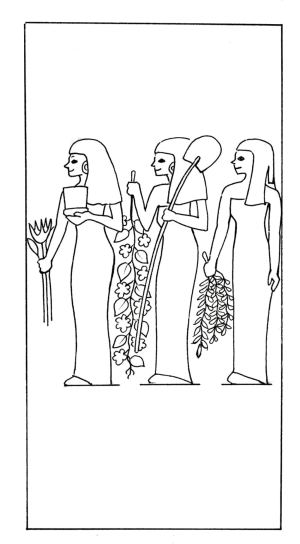 A painted wall (scene 1, right side) .... 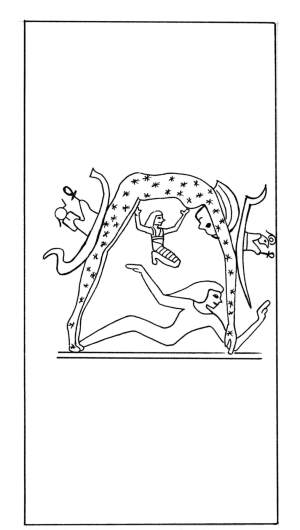 Mythological scene: sky, earth and sun (scene 2, left side) .... 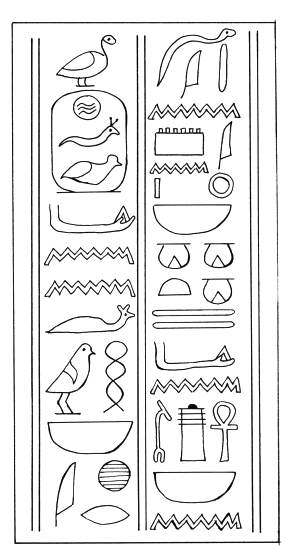 Hieroglyphic text showing a prayer for the Pharao, which is read top downward. (scene 2, central part) ....
The pyramid building site (scene 3,
central part)
Photos of a production:
|
||||||||||||||||||||||||||||||||||
|
webmaster: designcase.net Copyright © 2007 kinderspielentheater.de |
||||||||||||||||||||||||||||||||||

